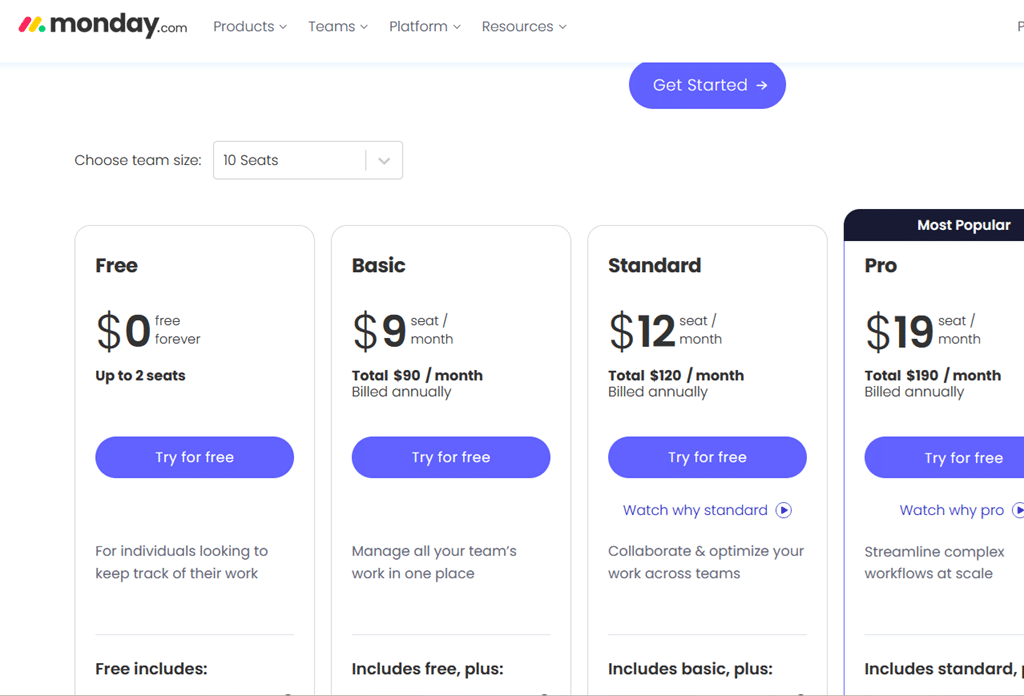
The Best 7 SaaS Pricing Models out there + Great Examples
The hottest pop-up on a SaaS pricing page is, of course, a free trial! However, a free trial lasting a week, two weeks, or even a month still does not solve the problem.
Which SaaS pricing model should you go with?
Once we have decided on a SaaS Pricing strategy (spoiler: combined pricing)
Let’s get started: Here are the top 7 SaaS Pricing models
- Please-Commit Pricing 🙏
- Feature-Based Pricing
- Per-User Pricing
- Per-Your Client Pricing
- Flat-rate Pricing
- Basic is always free
- Usage-Based Pricing
Pricing models for SaaS are not an exact science and are typically combined.
The Pros and Cons of each model are below + examples from the best SaaS companies in the world.
SaaS Pricing Model 1: Please-Commit Pricing
Please-Commit Pricing is all about saving money—if you commit, of course. Amazon’s Prime Service offers two pricing options to regular customers: a monthly price and an annual price.

Pros Please-Commit Pricing
- Easy to implement. The discount is given when committing to a year or more.
- A commitment of one year or more can assist in estimating the company’s future profits and thus enable proper budget planning.
- Clients who commit for one year or more are loyal customers. Therefore, it is possible to offer them additional products, services, or features for an extra charge.
- Potential clients can easily understand the difference in price between the two options, making it easier for them to decide on a one-year commitment.
- Little surprises. When clients commit to one year, you can surprise them throughout the year with updates and improvements to the product or service (such activities increase customer loyalty).
Cons Please-Commit Pricing
- The commitment goes both ways. The company also promises to provide an excellent product or service throughout the year.
- A one-year or longer commitment focuses less on the value of the product or service for the customer and more on the price. Thus, it is difficult to get the customer to spend more money on extras, like new features or various benefits.
SaaS Pricing Model 2: Feature-Based Pricing
Slack (a chat system for organizations and companies) offers a price for a basic package that includes a limited number of features. As more features are added, the package price increases accordingly.

Pros Feature-Based Pricing
- No surprises. Clients know exactly what they are paying for.
- Encourage clients to upgrade. Clients can easily compare the packages offered, and if the additional features are relevant to them, they will upgrade.
- Feature-based pricing is one of the models based on a value-based pricing strategy. Clients can appreciate how necessary each feature is for their business or not.
Cons Feature-Based Pricing
- Some SaaS companies (for example, data storage companies) offer packages with long and cumbersome lists of features. If comparing prices between packages is tedious and incomprehensible, clients may look for less detailed and easier-to-understand alternatives.
- Pricing is unclear to clients. Why do options a, b, and c cost more than d and e? When there is excessive detailing, customers do not always understand the pricing, which can hurt credibility.
SaaS Pricing Model 3: Per-User Pricing
The Per-User Pricing model is one of the most popular SaaS pricing models where the main clients are business clients and not private. Monday offers a project management SaaS product. At the pricing page entrance, customers are asked to indicate the size of their team.
Pricing changes according to the amount of “seats” you choose. The number of users determines the cost.

Pros Per-User Pricing
- Easy to understand. Customers recognize that every additional user raises the price.
- As the number of users increases, some SaaS companies lower the cost per user, thereby encouraging usage.
- It is possible to know in advance the expected profit from each company.
- This encourages your salespeople to seek out larger clients.
Cons Per-User Pricing
- The payment increases as more people use the product. Therefore, the leading value in pricing refers to quantity and ignores other important values for the clients.
- This does not necessarily encourage usage. Customers begin calculating which employees “really” need the product, and as a result, they become more cautious with their spending.
SaaS Pricing Model 4: Per-Your Client Pricing
Per-Your-Client pricing is the most common pricing model used by newsletters, text messaging companies, and other businesses that serve a substantial customer base (e.g., e-commerce sites). The well-known company Mailchimp offers a system for managing and sending newsletters. The first question asked on the pricing page is: ‘How many contacts do you have?’ The price increases as the mailing list grows.

Pros Per-Your client Pricing
- Easy to understand. Customers recognize that they are paying for each of their customers and each contact.
- As you gain more customers and, consequently, more contacts, some SaaS companies lower the cost per contact, thereby encouraging product use.
- This approach encourages your salespeople to target companies with a large customer base.
- It also encourages start-up companies to experiment with the product initially, as their customer base is small and the costs are low—often free in the case of Mailchimp.
Cons Per-Your Client Pricing
- The payment increases as clients themselves acquire more customers. Therefore, the leading value in pricing refers to quantity and ignores other important values for the clients.
- Start-up companies may move to your competitors as their number of clients increases in order to lower costs.
SaaS Pricing Model 5: Flat-Rate Pricing
A Flat-Rate Pricing is one of the easiest models for SaaS companies and for clients. A Flat-Rate Pricing is usually made in SaaS companies that serve more to private customers and less to business customers.
An example of a company that is using Flat-Rate Pricing is Skillshare. Skillshare is a SaaS company that offers online courses in a variety of fields.

Pros Flat-Rate Pricing
- Easy to understand; there is no information that customers supposedly missed.
- No surprises. There is flat-rate pricing, and there is no dependence on the method of use, the number of users, or the duration of usage.
- The product is easy to market because there is no need to elaborate on its use, the number of users, or usage time.
- Encourages usage. Customers are not afraid to try the product and are not worried about additional costs.
- When we use flat-rate pricing, it can assist in estimating the company’s future profits and thus enable proper budget planning.
Cons Flat-Rate Pricing
- Price may be a barrier to entry. When we use flat-rate pricing, if customers think it is too expensive, they may give up using the product altogether because the price is fixed, and there is no way to influence it.
- We leave money on the table. Some customers are willing to pay more for the product or for additional offers.
SaaS Pricing Model 6: Basic is always free Pricing
Basic is always free Pricing, basically allowing the use of the basic product for free. Each company defines the basic product differently and depending on the type of product. Zoom defines the basic product as a video call for up to 40 minutes per group or free of charge for two participants.

Pros Basic is always free Pricing
- It encourages use. If it’s free, why not try it?
- Once the product is free and customers are satisfied, the frequency of use will increase. Customers who use the product regularly become loyal customers. Therefore, it is possible to offer them additional products, services, or features for an extra cost.
- Free advertising. Free products are more easily shared by word of mouth. Customers are happy that it’s free and tend to recommend it to friends and colleagues.
Cons Basic is always free Pricing
- In a perfect world, customers would always be loyal. But we do not live in a perfect world. There is no guarantee that they will remain loyal, even if the product was offered for free. Customers will try to switch to another free competitor if they need to upgrade.
- We leave money on the table. Some customers are willing to pay for the base product.
- It’s hard to go back. If you want to start asking customers to pay for the base product, some will resist and try to move on to competitors.
- It’s expensive for the SaaS company. The company pays for the customers. Well, it’s good that we have venture capital funds, right?
SaaS Pricing Model 7: Usage-Based Pricing
Usage-Based Pricing, as it sounds. Customers only pay for the use, and the cost increases with the usage. Twilio offers a build-in system for contacting customers. For example, by text messages, emails, chats, WhatsApp, etc. Customers pay for using the API.

Pros Usage-Based Pricing
- It encourages customers to try the product because payment is based solely on usage. Customers tend to be optimistic and may not fully appreciate their product usage.
- Easy to understand. Customers know precisely what they are paying for.
- Easy to understand. Customers recognize that usage affects the price.
- As product usage increases, some SaaS companies lower the add-on costs, thereby encouraging further usage.
- In SaaS usage-based pricing, there are no long-term commitments or contracts. The price varies depending on usage.
Cons Usage-Based Pricing
- Excessive preoccupation with cost. Customers are surprised by the charges every month. When the cost is constantly changing, it becomes difficult to keep track of expenses.
- Therefore, the leading value in pricing refers to usage and ignores other important values for the clients.
Last sentences:
Models for SaaS Pricing is not an exact science. These models can be combined. For example, MailChimp offers a “Basic is always free” Pricing model combined with the “Per-Your Client” Pricing model. It is advisable to check and examine the pricing as a routine.
This post covers the following topics and questions: What is SaaS model pricing?, What is SaaS value based pricing model?, What are the 4 types of pricing strategies?, Usage-Based Pricing, Flat-Rate Pricing, SaaS Pricing Models
To read more posts on SaaS Marketing, click here.




Updated:
03, 2025